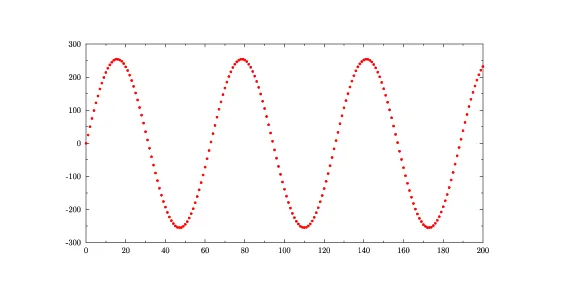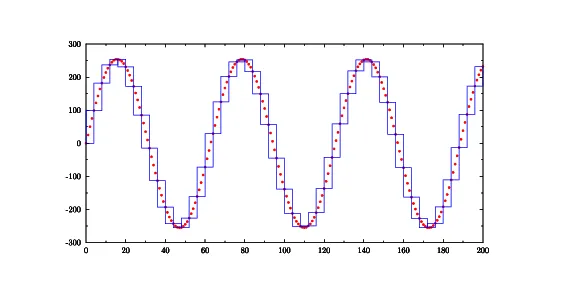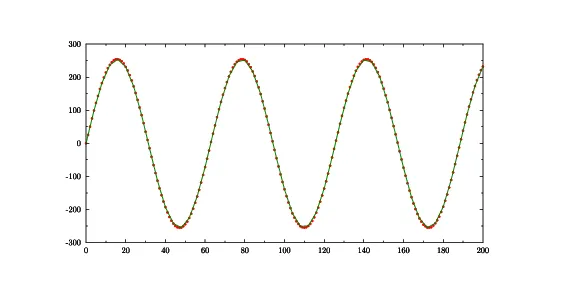我继承了一段绘制给定文件音频波形的代码片段。但是,这个波形只是使用JAVA矢量图形构建的简单图像,没有任何标签、轴信息等。我想将它移植到jfreechart上,以增加其信息价值。我的问题是,这段代码至少可以说是神秘的。
public class Plotter {
AudioInputStream audioInputStream;
Vector<Line2D.Double> lines = new Vector<Line2D.Double>();
String errStr;
Capture capture = new Capture();
double duration, seconds;
//File file;
String fileName = "out.png";
SamplingGraph samplingGraph;
String waveformFilename;
Color imageBackgroundColor = new Color(20,20,20);
public Plotter(URL url, String waveformFilename) throws Exception {
if (url != null) {
try {
errStr = null;
this.fileName = waveformFilename;
audioInputStream = AudioSystem.getAudioInputStream(url);
long milliseconds = (long)((audioInputStream.getFrameLength() * 1000) / audioInputStream.getFormat().getFrameRate());
duration = milliseconds / 1000.0;
samplingGraph = new SamplingGraph();
samplingGraph.createWaveForm(null);
} catch (Exception ex) {
reportStatus(ex.toString());
throw ex;
}
} else {
reportStatus("Audio file required.");
}
}
/**
* Render a WaveForm.
*/
class SamplingGraph implements Runnable {
private Thread thread;
private Font font10 = new Font("serif", Font.PLAIN, 10);
private Font font12 = new Font("serif", Font.PLAIN, 12);
Color jfcBlue = new Color(000, 000, 255);
Color pink = new Color(255, 175, 175);
public SamplingGraph() {
}
public void createWaveForm(byte[] audioBytes) {
lines.removeAllElements(); // clear the old vector
AudioFormat format = audioInputStream.getFormat();
if (audioBytes == null) {
try {
audioBytes = new byte[
(int) (audioInputStream.getFrameLength()
* format.getFrameSize())];
audioInputStream.read(audioBytes);
} catch (Exception ex) {
reportStatus(ex.getMessage());
return;
}
}
int w = 500;
int h = 200;
int[] audioData = null;
if (format.getSampleSizeInBits() == 16) {
int nlengthInSamples = audioBytes.length / 2;
audioData = new int[nlengthInSamples];
if (format.isBigEndian()) {
for (int i = 0; i < nlengthInSamples; i++) {
/* First byte is MSB (high order) */
int MSB = (int) audioBytes[2*i];
/* Second byte is LSB (low order) */
int LSB = (int) audioBytes[2*i+1];
audioData[i] = MSB << 8 | (255 & LSB);
}
} else {
for (int i = 0; i < nlengthInSamples; i++) {
/* First byte is LSB (low order) */
int LSB = (int) audioBytes[2*i];
/* Second byte is MSB (high order) */
int MSB = (int) audioBytes[2*i+1];
audioData[i] = MSB << 8 | (255 & LSB);
}
}
} else if (format.getSampleSizeInBits() == 8) {
int nlengthInSamples = audioBytes.length;
audioData = new int[nlengthInSamples];
if (format.getEncoding().toString().startsWith("PCM_SIGN")) {
for (int i = 0; i < audioBytes.length; i++) {
audioData[i] = audioBytes[i];
}
} else {
for (int i = 0; i < audioBytes.length; i++) {
audioData[i] = audioBytes[i] - 128;
}
}
}
int frames_per_pixel = audioBytes.length / format.getFrameSize()/w;
byte my_byte = 0;
double y_last = 0;
int numChannels = format.getChannels();
for (double x = 0; x < w && audioData != null; x++) {
int idx = (int) (frames_per_pixel * numChannels * x);
if (format.getSampleSizeInBits() == 8) {
my_byte = (byte) audioData[idx];
} else {
my_byte = (byte) (128 * audioData[idx] / 32768 );
}
double y_new = (double) (h * (128 - my_byte) / 256);
lines.add(new Line2D.Double(x, y_last, x, y_new));
y_last = y_new;
}
saveToFile();
}
public void saveToFile() {
int w = 500;
int h = 200;
int INFOPAD = 15;
BufferedImage bufferedImage = new BufferedImage(w, h, BufferedImage.TYPE_INT_RGB);
Graphics2D g2 = bufferedImage.createGraphics();
createSampleOnGraphicsContext(w, h, INFOPAD, g2);
g2.dispose();
// Write generated image to a file
try {
// Save as PNG
File file = new File(fileName);
System.out.println(file.getAbsolutePath());
ImageIO.write(bufferedImage, "png", file);
JOptionPane.showMessageDialog(null,
new JLabel(new ImageIcon(fileName)));
} catch (IOException e) {
}
}
private void createSampleOnGraphicsContext(int w, int h, int INFOPAD, Graphics2D g2) {
g2.setBackground(imageBackgroundColor);
g2.clearRect(0, 0, w, h);
g2.setColor(Color.white);
g2.fillRect(0, h-INFOPAD, w, INFOPAD);
if (errStr != null) {
g2.setColor(jfcBlue);
g2.setFont(new Font("serif", Font.BOLD, 18));
g2.drawString("ERROR", 5, 20);
AttributedString as = new AttributedString(errStr);
as.addAttribute(TextAttribute.FONT, font12, 0, errStr.length());
AttributedCharacterIterator aci = as.getIterator();
FontRenderContext frc = g2.getFontRenderContext();
LineBreakMeasurer lbm = new LineBreakMeasurer(aci, frc);
float x = 5, y = 25;
lbm.setPosition(0);
while (lbm.getPosition() < errStr.length()) {
TextLayout tl = lbm.nextLayout(w-x-5);
if (!tl.isLeftToRight()) {
x = w - tl.getAdvance();
}
tl.draw(g2, x, y += tl.getAscent());
y += tl.getDescent() + tl.getLeading();
}
} else if (capture.thread != null) {
g2.setColor(Color.black);
g2.setFont(font12);
//g2.drawString("Length: " + String.valueOf(seconds), 3, h-4);
} else {
g2.setColor(Color.black);
g2.setFont(font12);
//g2.drawString("File: " + fileName + " Length: " + String.valueOf(duration) + " Position: " + String.valueOf(seconds), 3, h-4);
if (audioInputStream != null) {
// .. render sampling graph ..
g2.setColor(jfcBlue);
for (int i = 1; i < lines.size(); i++) {
g2.draw((Line2D) lines.get(i));
}
// .. draw current position ..
if (seconds != 0) {
double loc = seconds/duration*w;
g2.setColor(pink);
g2.setStroke(new BasicStroke(3));
g2.draw(new Line2D.Double(loc, 0, loc, h-INFOPAD-2));
}
}
}
}
public void start() {
thread = new Thread(this);
thread.setName("SamplingGraph");
thread.start();
seconds = 0;
}
public void stop() {
if (thread != null) {
thread.interrupt();
}
thread = null;
}
public void run() {
seconds = 0;
while (thread != null) {
if ( (capture.line != null) && (capture.line.isActive()) ) {
long milliseconds = (long)(capture.line.getMicrosecondPosition() / 1000);
seconds = milliseconds / 1000.0;
}
try { thread.sleep(100); } catch (Exception e) { break; }
while ((capture.line != null && !capture.line.isActive()))
{
try { thread.sleep(10); } catch (Exception e) { break; }
}
}
seconds = 0;
}
} // End class SamplingGraph
/**
* Reads data from the input channel and writes to the output stream
*/
class Capture implements Runnable {
TargetDataLine line;
Thread thread;
public void start() {
errStr = null;
thread = new Thread(this);
thread.setName("Capture");
thread.start();
}
public void stop() {
thread = null;
}
private void shutDown(String message) {
if ((errStr = message) != null && thread != null) {
thread = null;
samplingGraph.stop();
System.err.println(errStr);
}
}
public void run() {
duration = 0;
audioInputStream = null;
// define the required attributes for our line,
// and make sure a compatible line is supported.
AudioFormat format = audioInputStream.getFormat();
DataLine.Info info = new DataLine.Info(TargetDataLine.class,
format);
if (!AudioSystem.isLineSupported(info)) {
shutDown("Line matching " + info + " not supported.");
return;
}
// get and open the target data line for capture.
try {
line = (TargetDataLine) AudioSystem.getLine(info);
line.open(format, line.getBufferSize());
} catch (LineUnavailableException ex) {
shutDown("Unable to open the line: " + ex);
return;
} catch (SecurityException ex) {
shutDown(ex.toString());
//JavaSound.showInfoDialog();
return;
} catch (Exception ex) {
shutDown(ex.toString());
return;
}
// play back the captured audio data
ByteArrayOutputStream out = new ByteArrayOutputStream();
int frameSizeInBytes = format.getFrameSize();
int bufferLengthInFrames = line.getBufferSize() / 8;
int bufferLengthInBytes = bufferLengthInFrames * frameSizeInBytes;
byte[] data = new byte[bufferLengthInBytes];
int numBytesRead;
line.start();
while (thread != null) {
if((numBytesRead = line.read(data, 0, bufferLengthInBytes)) == -1) {
break;
}
out.write(data, 0, numBytesRead);
}
// we reached the end of the stream. stop and close the line.
line.stop();
line.close();
line = null;
// stop and close the output stream
try {
out.flush();
out.close();
} catch (IOException ex) {
ex.printStackTrace();
}
// load bytes into the audio input stream for playback
byte audioBytes[] = out.toByteArray();
ByteArrayInputStream bais = new ByteArrayInputStream(audioBytes);
audioInputStream = new AudioInputStream(bais, format, audioBytes.length / frameSizeInBytes);
long milliseconds = (long)((audioInputStream.getFrameLength() * 1000) / format.getFrameRate());
duration = milliseconds / 1000.0;
try {
audioInputStream.reset();
} catch (Exception ex) {
ex.printStackTrace();
return;
}
samplingGraph.createWaveForm(audioBytes);
}
} // End class Capture
我已经多次阅读它,知道下面的部分是计算音频值的地方,但我的问题是,我不知道如何在那个点检索时间信息,即该值属于什么时间间隔。
int frames_per_pixel = audioBytes.length / format.getFrameSize()/w;
byte my_byte = 0;
double y_last = 0;
int numChannels = format.getChannels();
for (double x = 0; x < w && audioData != null; x++) {
int idx = (int) (frames_per_pixel * numChannels * x);
if (format.getSampleSizeInBits() == 8) {
my_byte = (byte) audioData[idx];
} else {
my_byte = (byte) (128 * audioData[idx] / 32768 );
}
double y_new = (double) (h * (128 - my_byte) / 256);
lines.add(new Line2D.Double(x, y_last, x, y_new));
y_last = y_new;
}
我希望使用jfreechart的XYSeriesPlot绘制它,但是在计算所需的x(时间)和y(这是幅度,但在此代码中是否为y_new)方面遇到了麻烦。
我知道这是一件非常简单的事情,但我对整个音频问题还很陌生。我理解音频文件背后的理论,但这似乎是一个简单的问题,却有一个棘手的解决方案。 进入链接描述
 然后,绘图代码将数据表示为图形中的蓝色框:
然后,绘图代码将数据表示为图形中的蓝色框:
 当方框宽度为1像素时,这对应于端点为
当方框宽度为1像素时,这对应于端点为 理论上,您可以将每个样本原样提供给XYPlot。但是,除非您只有少量样本,否则这往往会导致绘图的负担很重。因此,通常会先对数据进行下采样。如果波形足够平滑,则下采样过程会减少到降采样(即每N个样本取1个)。然后,降采样因子N控制呈现性能和波形近似精度之间的权衡。请注意,如果提供的代码中使用的降采样因子
理论上,您可以将每个样本原样提供给XYPlot。但是,除非您只有少量样本,否则这往往会导致绘图的负担很重。因此,通常会先对数据进行下采样。如果波形足够平滑,则下采样过程会减少到降采样(即每N个样本取1个)。然后,降采样因子N控制呈现性能和波形近似精度之间的权衡。请注意,如果提供的代码中使用的降采样因子